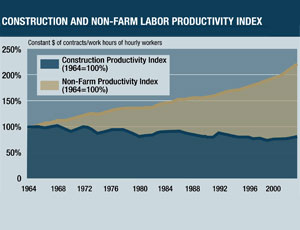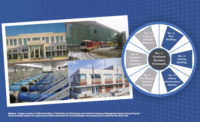A widespread adoption of lean techniques, integrated teaming and virtual design and construction could be the keys to improving productivity in the construction industry, according to a new report released by the National Research Council. The report, “Advancing the Competitiveness and Efficiency of the U.S. Construction Industry,” focuses on reducing waste in time, cost, materials, energy, skills and labor and offers recommendations on how to promote industry-wide adoption over the next 20 years.
“This is the most important topic in the industry right now, but it’s one that has continued to falter, and ultimately no one does anything substantive about it,” says Pat Galloway, CEO of Pegasus-Global Holdings in Cle Elum, Wash., and a member of the committee that oversaw the study.
Productivity has been a hot-button issue in recent years, particularly following a 2004 analysis by Dr. Paul Teicholz of Stanford University. It suggested that construction labor productivity declined by nearly 20% between 1964 and 2003, while other non-farm industries improved by more than 200%.
Drawing from three white papers and a two-day workshop with industry experts, the committee homed in on five connected approaches that represent “opportunities for breakthrough improvements” in efficiency over the next two to 10 years. Among the techniques promoted in the report are greater use of prefabrication, preassembly, modularization and offsite fabrication, as well as widespread use of interoperable technology, such as building information modeling.
Greater integration between team members is also listed as an opportunity to improve jobsite efficiency through effective interfacing of people, process, materials, equipment and information.
Although many such approaches have gained momentum in recent years, they’ve yet to reach critical mass, some experts say. Kevin Bredeson, director of virtual construction at Providence, R.I.-based Gilbane Building, says his company has seen high return on investment in projects that use building information modeling.
“New England is our largest region by revenue, and yet it is farther behind than most areas in adoption [of BIM],” he says. “That keeps us from being fully integrated on every project and realizing even better results… It’s a ...




Post a comment to this article
Report Abusive Comment